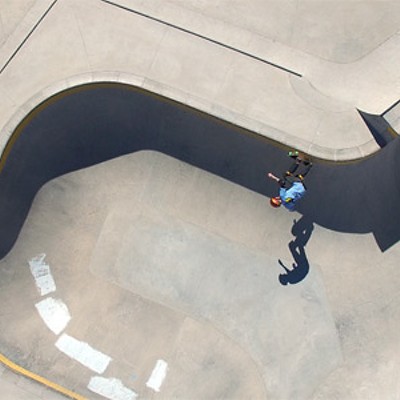Halifax became a major sports town for a day last June, when the Canadian Football League staged a game at Huskies Stadium, home of the Saint Mary’s Huskies. Before a crowd of 11,000 fans, the Toronto Argonauts and the Hamilton Tigercats played to a 16-16 tie. It went much better than the last time the CFL visited the Maritimes. In 1987, 4,000 people stayed through a downpour to watch the Tigercats play the Winnipeg BlueBombers in Saint John, New Brunswick. Dubbed Touchdown Atlantic, June’s Halifax exhibition game between the two Ontario outfits was unveiled by CFL commissioner Tom Wright and Events Halifax chairman Fred MacGillivray in December of 2004, as a litmus test for a possible tenth franchise for the CFL. The venture, which saw over 8,000 seats added to Huskies Stadium, pumped new life into the longstanding dream of an east coast CFL team.
Unfortunately, the hopes of local fans and the CFL’s board of governors to inject a Maritime presence into the CFL landscape are stalled at similarly longstanding brick walls: lack of a stadium and lack of financing.
The last serious effort to bring the CFL east happened in the early 1980s, with a team called the Atlantic Schooners. The Schooners ownership group was lead by captain of industry RB Cameron, from Maritime Steel, and serious football guy JL Albrecht, who had been the head of player development for the National Football League’s New England Patriots.
The Schooners are at the heart of an enduring local sports myth. The ownership group bought a scoreboard from the Patriots (doubtless through Albrecht’s connections), hoping to use it in a Schooners stadium to bring some kind of credibility to the team. But at the annual CFL board of governor’s meeting on May 5, 1983, the league took the wind out of the sails of the Schooners’ bid. The franchise had failed to meet the basic requirements the CFL had imposed, mainly a $900,000 non-refundable cheque from the Schooners’ financial backers. The teams’ burgeoning ownership group was more than a little hesitant to commit that much money to a team that lacked an adequate stadium. In May ’83 the Montreal Gazette quoted Schooners’ president John Donoval claiming the federal government had reneged on a financial commitment to help build the facility.
The team petitioned the CFL for an extension to allow financing details for a stadium to be worked out, but the league, led by then CFL commissioner Jake Gaudaur, was skeptical — and with reason. The last time Halifax had received an infusion of federal cash for sports was during the first Canada Summer Games in 1969.
Rumour has that Patriots scoreboard tucked away in the corner of a long-forgotten metro warehouse, waiting for just the time it’s needed.
Despite its current status as a professional sports wasteland—Mooseheads players are technically not supposed to be paid—Halifax has a storied pro past, especially in hockey. Long before Sidney Crosby arrived, Larry Robinson was Halifax’s young hockey sensation. Robinson spent two seasons with the American Hockey League’s Nova Scotia Voyageurs as their top defensemen, plying his trade for head coach and Nova Scotia native Al MacNeil before moving on to a hall-of-fame career with the Montreal Canadiens.
From 1971 until 1984, the Nova Scotia Voyageurs brought AHL action to the Halifax Forum and the Halifax Metro Centre. John Brophy is the former head coach of the Vees and a member of Nova Scotia’s Sports Hall of Fame. He’s re-located to New Jersey and removed from a coaching career that spanned six decades and has taken him from Birmingham to Toronto to Hamptons Roads and everywhere in-between. The inspiration for Paul Newman’s tough talking player-coach in the cult favourite SlapShot, Brophy still has a soft spot for Halifax, calling his days here “absolutely the best time I ever had in my life.”
The Halifax Citadels came to town as a farm club of the Quebec Nordiques, replacing the Nova Scotia Oilers (1984-1988), who in turn had replaced the Nova Scotia Voyageurs. Ken McRae, a veteran of 138 NHL games, spent parts of three seasons in the AHL with the Halifax Citadels and reiterates Brophy’s statements. McRae cites Halifax as one of the best cities he played pro hockey in. That’s high praise from a man who has played in hockey meccas like Toronto and Detroit.
“After you won a couple of home games, it was always nice to go out the backdoor to a place like My Apartment and have a cold beer where everyone was talking hockey,” says McRae.
The Citadels were not an offensive force; they made their mark in the AHL with their fists, not by scoring goals. In marked contrast to Halifax’s reputation as polite and amiable, the Citadels rarely treated visiting teams with welcoming arms. While sending out bruisers like Serge Roberge, Greg Smythe, Trevor Steinburg (now head coach of the St Mary’s Huskies) and McRae, the Citadels topped 2,000 minutes in the sin bin in three straight seasons. Games against rivals like the Cape Breton Oilers were fierce, foreshadowing the battles to come between the Mooseheads and the Screaming Eagles.
“Any time you had games against Cape Breton, you knew you weren’t going to have an easy time... was a great building to play in,” says McRae.
Jacques Mailhot, a legendary Citadels pugilist whose fight card reads like a who’s who of hockey tough guys, cements the Citadels’ reputation as a rough and irascible team. Mailhot remembers a particularly intense play-off game against Moncton, when he was sidelined with an injury.
“I wasn’t playing and Greg Smythe got ejected from the game. On the way out to the locker room, he got in a fight with some fans and the whole team came over to his help. I was trying to calm things down when a helmet flew a few inches from my head and almost knocked me down.”
The Citadels may have been among the league leaders when it came to the rough stuff, but it didn’t help them at the gate. In their last season, the Citadels were ranked number 13 out of 16 teams, drawing 2,957 per game, less than a third of the Metro Centre’s capacity.
Halifax had lucked out with the Voyageurs as their parent Montreal Canadiens, an NHL powerhouse, believed in stocking their Maritime farm team with a mix of young up-and-comers and veteran players. The Nordiques, however, an NHL doormat in the late ’80s and early ’90s, could not enjoy the luxury of bringing their best young players along slowly. The top youngsters, who would normally toil in the AHL for a couple of seasons, were forced to sink or swim in the NHL with Quebec, away from the cheers of the fans in Halifax. Saddled with teams often depleted due to call-ups, the Halifax Citadels could never enjoy the consistency that the Voyageurs and other AHL teams had and which allowed them to bring three AHL championships to Halifax. The Citadels and their faithful suffered through three straight seasons of non-playoff hockey. In 1993 the Citadels found themselves out of the AHL entirely and Halifax was out of professional hockey for the first time in over 20 years.
Halifax’s professional sports scene died a little more when the National Basketball League folded in mid-season a year later; though it’s unclear as to whether anyone noticed. The Windjammers seemed to have more lives than the proverbial cat. They refused to say die when the World Basketball League folded in 1992, in the wake of a $350 million fraud and embezzlement investigation, with their founder, Mickey Monus, at the centre. The WBL, despite teams with colourful names like the Youngstown Pride, the Florida Jades, and the Erie Wave, suffered from a cartoonish reputation from the start when it implemented height restrictions of 6’5” on its players. The Halifax franchise, owed $65,000 by the league, stuck around with three of the league’s ten teams to finish a final profitless WBL playoff in 1992. The Windjammers found themselves as an inaugural franchise in the fledgling National Basketball League in 1993. Due to poor marketing the league was riddled with attendance problems from the opening tip-off, but it soldiered on for a second season.
The Windjammers were in first place in the 1994 season with a .714 winning percentage. Unfortunately, they were also saddled with a debt of $12,000 payable to the league’s head office. They weren’t alone, as every team in the league had failed to come up with the franchise fees for that season. The owners of the six NBL teams, all of whom were in financial dire straits, voted to disband the league in the early morning hours of July 9, 1994, and then, in a move characteristic of the NBL, decided not to tell anyone, including the league’s head office, until just before midnight that night. The demise of the NBL had been foreshadowed the previous season when the regular season champions, the Cape Breton Breakers, couldn’t afford to fly any of its players home for the playoffs and the entire championship final was played in Saskatoon. Legend has it that several Cape Breton Breakers are still stranded there.
Heartbreak seems to be a prerequisite for any fan of local sports teams in Halifax. Disappointment didn’t disappear with the arrival of the Quebec Major Junior Hockey League’s Mooseheads. The Herd has been defeated in the QLeague playoff final twice, but remains an unmitigated success off the ice and a perennial QMJHL contender.Perhaps it will be a non-professional team that reverses the fortunes of Halifax’s sports scene. With an average of approximately 7,000 fans per game, Mooseheads fans don’t fear losing their team the way fans of the AHL, NBL and WBL did. With the Mooseheads routinely selling out home games, John Brophy is clearly not alone when he says that as a hockey city, as a sports city, “Halifax has always been number one in my cards, that’s for sure.”











